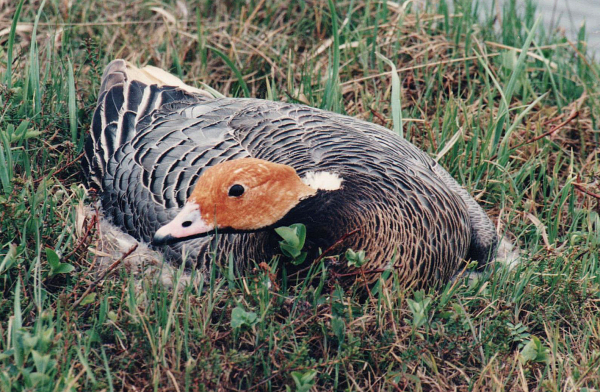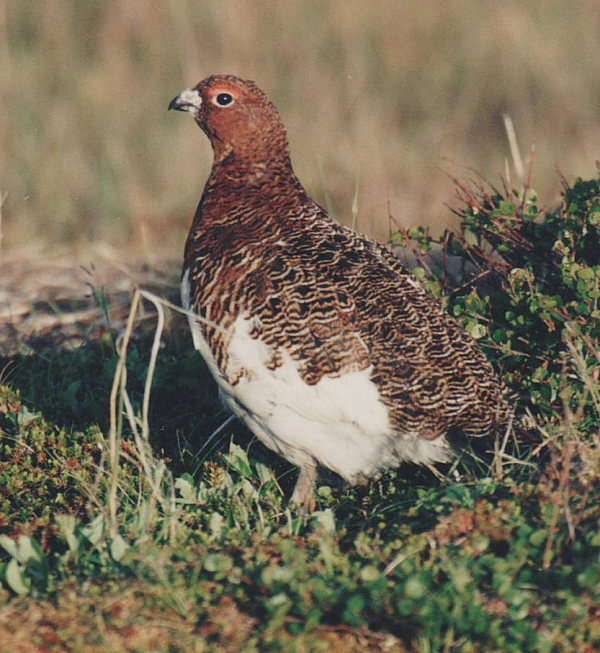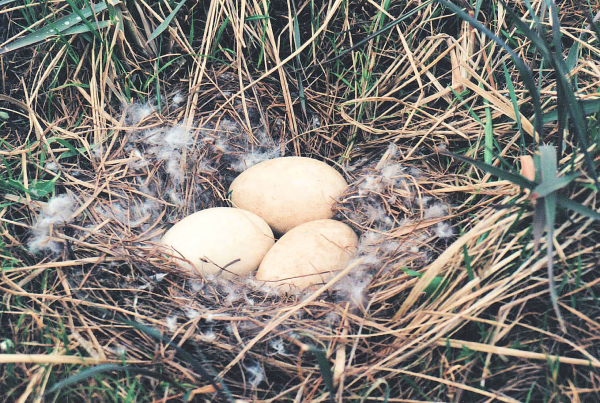
The ultra-rare opportunity to photograph an incubating Emperor Goose on her nest was the ultimate Arctic experience. Stained by dissolved natural chemicals in the water, all Emperor Geese in the region have orange heads during the nesting season, rather than the usual white head plumage prevalent during other seasons – and in field guides.

A male Willow Ptarmigan was photographed adjacent to camp, where it was regularly seen, sometimes in company with a female.

A White-fronted Goose nest will with large eggs that were probably about to hatch when the photo was taken. (Paul took the photo while accompanying a biologist who was checking the status of the nest during on-going research.)
|
Each year during the third week of June I celebrate the peak of hatching among Arctic-nesting geese. One June, I traveled to one of the premier goose nesting locations in North America – the Yukon River Delta – to experience the nesting season among four nesting goose populations and a wealth of ducks, shorebirds, and such outstanding birds as Tundra Swans, Lesser Sandhill Cranes, Willow Ptarmigan, Red-throated Loons, Lapland Longspurs, and more.
Ready for a wilderness adventure, I wanted to experience the nesting season in the Arctic tundra, but most of all wanted to visit the greatest wetland region in North America. These interests would be fulfilled during my journey to the Yukon River Delta in western edge of Alaska. This was not a quick and simple trip – it took decades of hope, years of planning, and weeks of follow through.
I scheduled my trip for the third week in June, the action-packed period of the nesting season when hatching would peak for the four species of nesting geese – Emperor Geese, White-fronts, Cackling Geese, and Brant. In addition, nesting activity was in full swing for a variety of ducks, Tundra Swans, Sandhill Cranes, Willow Ptarmigan, Pacific and Red-throated Loons, Long-tailed and Parasitic Jaegers, Sabine’s Gulls, and many species of sandpipers and plovers.
From the eastern edge of the 30 million acre Yukon River Delta, we flew from Bethel, Alaska, over the vast complex of tundra and shallow wetlands that continued miles and miles to Hooper Bay on the Bering Sea Coast, then we flew south to the Yupik outpost of Chevak. There, I walked from the runway to the shore of the Kashunuk River and hopped into a small motorboat that took me downstream into the heart of the great Yukon River Delta.
The exciting 90-minute boat trip provided my first glimpses of the abundant birdlife and the last leg of my long trip from Los Angeles to the River Camp set up for biologists conducting nesting bird surveys in the region. I had arranged to spend a week with the small group, and after a quick hello and good-bye from two departing biologists, I was alone, ready to explore the expansive tundra and wetland complex that extended on both sides of the river.
After setting up my backpacking tent, adding to the base camp of six tents the biologists used, and fighting off the first swarm of mosquitos, I grabbed my camera and binoculars and started my first hike. Within 100 yards of camp, a variety of shorebirds were active on nesting territories, including Western Sandpipers, Black and Ruddy Turnstones, Dunlins, Red-necked Phalaropes, and Wilson’s Snipe. I also enjoyed watching one of the most sought-after birds in the area – a Bristle-thighed Curlew – along with a Willow Ptarmigan that still showed some winter white coloration, Long-tailed Jaegers, Tundra Swans, Long-tailed Ducks, Green-winged Teal, and the geese – Emperors, White-fronts, and Cackling Geese. Wow, what a place!
Anyone visiting this region must wear hip waders to make their way through the watery tundra mosaic, and I wore my waders from the time I dressed in the morning until I prepared to slip into my sleeping bag at night. As I walked farther afield, I enjoyed observing Bar-tailed Godwits, Lesser Sandhill Cranes, Emperor Geese, White-fronts, White-winged Scoters, Greater Scaup, Northern Shovelers, and Tundra Swans.
During that first hike I was lucky enough to find the nest of a pair of Tundra Swans, no great feat considering how conspicuous the incubating adult was on a slightly elevated ridge. Seeing a nesting Tundra Swan fulfilled a wish of a lifetime, and as the week progressed many more of my birding dreams came true.
My biggest wish was to photograph a nesting Emperor Goose – a lofty wish indeed. Emperor Geese were relatively common in the area, but during the first couple days none presented an opportunity for more than a long-distance documentary photo or two. About mid-week, after miles of slogging cross the wet tundra in heavy hip waders, I took a “wrong turn” and became bogged down in the thick mud of a drying pond. As I struggled to pull myself out of the deep muck, I stepped carefully to a firmer, grass-covered shoreline.
There, my attention was still focused on the ground when I stopped to catch my breath, but I looked up to see something that made my excitement level jump as I gasped in surprise. Only a couple steps in front of me was a beautiful Emperor Goose pressing her body, neck, and head tight against the ground, concealing the goose-down nest beneath her. My heart was already pounding from my unexpected workout in the mud, but now my heart thumped even harder as I eased my backpack off my shoulder and removed my camera, which was fitted with a 100-to-300mm zoom lens.
I quickly composed the ultimate nesting Empress image and took the first couple photos, zooming in to get some full-framed images. Next, I carefully kneeled to get down to the goose’s eye level to take more photos as she raised her head as though less concerned with my bumbling advance. This was the ultimate Yukon Delta experience for me, and I made the most of it as I took some of my favorite photos of this impressive Emperor Goose. It was a true Arctic highlight!
I was also thrilled to find nests of several other species too, including Western Sandpipers, Red-necked Phalaropes, Dunlins, Common Snipe, White-fronted Geese, Cackling Geese, Northern Pintails, Green-winged Teal, Sabine’s Gulls, Glaucous Gulls, and Lapland Longspurs. Some nests contained a full clutch of eggs, and a few were filled with newly hatched broods.
Many years before, my friend Roger Tory Peterson camped just a few miles upriver from the biologist’s camp where he described this expansive land of tundra, wetlands, and birds: “We are now quite prepared to believe this is the most bird-rich tundra in all the Arctic world.” Although I read this description after returning from the Yukon River Delta, it was good to know I had experienced the best, and had reason to believe Roger’s description was absolutely true! Today, much of this vast area is protected by the largest refuge in the United States, the Yukon River National Wildlife Refuge.
There really wasn’t much of a night during this week of summer solstice; the sun set about 1:00am and slipped back above the horizon about 4:30am, so it really never became dark at night. In fact, during stormy days it was darker during the day than at night. Overall, the trip required a level of roughing it – tolerating cold, wind, and rain in my flimsy tent – and I’ve never gone a week without a shower, bath, or swim; but there’s a first time for everything.
During this week, it was an exciting experience to witness the variety of Arctic-nesting birds, experience their behaviors, hear their songs and calls, and see them in alternate (breeding) plumage, as well as to see the natal plumage of hatchlings, and watch flocks and individuals flying over the open expanse of tundra near the Bering Sea Coast. The importance of this trip to the Arctic tundra was certainly to provide me with an understanding of the tundra-wetland ecosystem, as well as first-hand knowledge of the birds that inhabit the Yukon River Delta during the peak of the nesting season. What a thrill.
Article and photos by Paul Konrad
Share your birding sightings and photos at editorstbw2@gmail.com